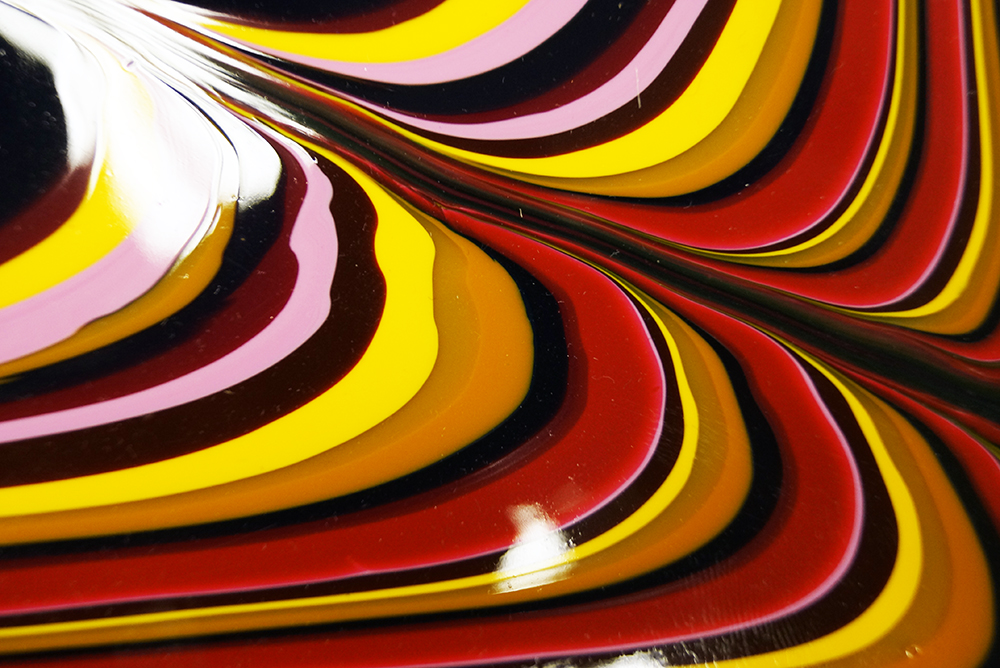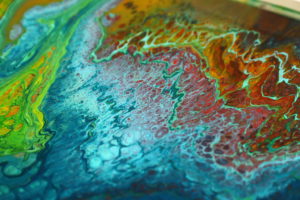How Long to Wait for Drip Art to Dry
While the practise of pouring artist paints is certainly non a new style to use paint, achieving consistent results tin can be frustrating and costly. Yet, information technology is vital to the process to conduct experiments to gain the knowledge of what are the most critical decision-making factors which preside over paint pours.
Studio Preparation

One sure manner to better the odds for successful pouring is to beginning with a clean studio. Acrylic pours are relatively wearisome drying paint layers and dust can easily become imbedded into the film. Take some fourth dimension to free the immediate workspace, sweeping the floor and wiping down surfaces around the studio. Side by side, be sure the table top or floor you are working on is also clean and level. Even slight angles can cause problems withpours. Put downwards fresh poly plastic sheeting on the surface which will protect the surface andhelp subsequently on by preventing your artwork from becoming glued to the work surface, equally pouring products creates puddles and drips that tin can travel off of the canvas or panel. Finally, control the temperature and humidity level in the studio equally much equally possible. Dry climates increment the chance of crazes developing – fissures resulting from liquid acrylic products skinning over during initial drying while the underlying liquid paint is still very fresh. The skin shrinks and tears apart resulting in unwanted physical textures known as a "craze" (run into Image 1).
Painting Substrates
The nearly anticipated painting surface for pours is a sealed panel. This surface is less affected past the weight of the wet product compared to stretched canvas. Of class, the panel needs to be resistant to warping from water, thus sealing the surface with 1 or more than coats of acrylic medium (or paint) is helpful. Conversely, this advice may exist counter-productive if your technique relies upon the surface absorbency and/or the ability to bend the substrate in guild to control the paint movement. This is why testing is such a critical cistron even when using products that other artists find successful. If working on stretched canvas is vital to your process, yous may be able to eliminate the sagging by stretching over a wooden panel or using a cardboard block between the stretcher bars.
Paints and Mediums used for Pouring Applications
Free-flowing liquid paints and mediums are at the center of the pouring process. Adjusting the viscosity and flow rate to work in tandem with how you want the paints to interact with each other is cardinal. Obviously, products like GOLDEN Fluid Acrylics and Loftier Period Acrylics are more practical when doing pours than thicker Heavy Torso Acrylics. This is not to say you cannot use Heavy Body paints, but they will first require thinning with water, acrylic medium, or both. A great arroyo for thinning Heavy Body paints without a loss of film strength is to first mix a thin acrylic medium such as GAC 100 with water (ane role medium to 1.five parts water, and so utilize this mixture to thin the paints as much as desired). This mixture assures quick thinning but contains enough acrylic binder so that you yet terminate upwards with a pourable pigment instead of a colour stain mixture. Since Fluids and High Menses Acrylics are already pourable, this pace isn't required to work with them, but sometimes it is necessary to adjust these paints too. GOLDEN Airbrush Transparent Extender is also a valuable medium for adjusting paints. This product is a like consistency to High Flow Acrylics, containing menstruum improvers and leveling additives.
Although virtually acrylic mediums are inherently pourable, some are meliorate suited for pouring than others. GAC 800 is a medium specifically produced to modify paints for pouring, such as when pouring a puddle onto a paint surface. The GAC 800 mixes readily with the Fluid Acrylics and this combination is the least likely to craze during drying. Information technology's however possible GAC 800 may craze, but this is commonly the result of also much paint being added and in turn, countering the acrylic solids level or the cascade has been practical in too thick of a layer. A great starting point is to mix one function pigment into x parts GAC 800 and limit the thickness to how far the product volition spread. In other words, pour the product into a pancake pool, and permit it seek its ain thickness without impeding its flow by employ of a taped off or dammed edge. Once these tests are done you may want to effort other paint amounts and use edges to control the menstruum, but exist wary of too thick of a cascade to start. The biggest negative attribute of GAC 800 is "dry out country clarity". This medium retains a slight cloudy quality making it a poor choice as a articulate topcoat or even transparent colour layer.
Other mediums to experiment with include GAC 500, Polymer Medium (Gloss), Fluid Matte Medium, Self-Leveling Articulate Gel and Articulate Tar Gel. I important note worth mentioning is that these products were not adult with defect-gratis pouring in listen, and although smooth thin layers are possible when using them, they are non free of issues and limitations. For example, a mutual misconception is that Self-Leveling Articulate Gel tin be poured liberally and spread around with palette knives, trowels and squeegees and level perfectly upon drying. This is not the case, and some tool marks, however slight, will likely remain in the stale layer. Tool shape and application technique are critical to their success, and artists who take mastered their use have spent many frustrating nights in their studio figuring out the best awarding method that provides the desired results. Every bit a place to start, use make clean, large tools with shine edges and advisedly spread the product in multiple thin coats until the desired issue is attained. Allow i to three days drying between coats to reduce the risk of crazing and don't be put off if every layer isn't a perfect epoxy like surface, every bit perfection is nearly impossible to reach in layers of air drying products.

Pouring Application Techniques
In that location are as many methods every bit at that place are product combinations to attempt. First, appreciate each paint color every bit its own unique formula and pigments vary in their density and ability to movement and spread. The same is true for the many acrylic mediums produced. Now cistron in the add-on of h2o, Retarder, or diluted Acrylic Flow Release. Toss in the impact of the painting substrate and studio environment and suddenly, predictable pouring seems unattainable. The way to all-time depict the arroyo to pouring applications is the concept of setting the stage to permit the products to do what they desire to practice; in other words, controlled chaos. And if yous don't take good studio notes to identify how each painting is created and then you'll never be able to reproduce a not bad event when they happen. That said, here are some common methods and beginning mixtures to try out:
- Thinned Color Washes – High Flow Acrylics are gear up to use for this application. The colors will readily move and interact. Try them cracking, mixed with mediums like Airbrush Transparent Extender or GAC 500 and let gravity move them effectually. Fluid Acrylics will require at least 10% additions with h2o to allow them to freely motion near. Note: high additions of water increment surface tension, which can be countered by adding in 2 or 3% Acrylic Menses Release into the water prior to using it to thin paints. Practise not over-add together Acrylic Flow Release as it does non help ameliorate flow, it'south intended to reduce surface tension which happens rapidly.
- Solid Color Pours – Equally mentioned previously, GAC 800 is a great medium to employ with Fluid Acrylics for making colored pours (meet Image 2). Ideally start effectually 10 parts GAC 800 to 1 office Fluid Acrylic, mix and shop the paint overnight in a sealed container. This allows the bubbles incurred during mixing to ascension and pop, resulting in clean pours with sharp edges. These mixtures produce clear colour edges. Solid color pours tin can be used over an unabridged canvas, just avoid damming upwards the edges during drying.
- Calculation Isopropyl Alcohol into Acrylic Paint – Alcohol is less dense than water, and evaporates quickly one time it hits the surface of a pour. Dissimilar other applications, the booze amount for this technique is relatively low because one time the upshot happens and it escapes the fresh pour, in that location needs to be sufficient time for the normal acrylic paint curing process to

Paradigm 3: Pours of GAC 800, GOLDEN High Flow Acrylic & Isopropyl Booze create cellular patterns every bit the alcohol tries to escape the paint during drying. occur to avoid moving picture formation problems. An effective starting recipe is 2 parts GAC 800, 1 part Loftier Flow Acrylic, and 1 part seventy% isopropyl alcohol. Create three or more than pigment mixtures in containers which can be shaken without spilling and carefully pour one colour on top of some other. Dense pigments like Titanium White should exist used as the final layers so that the more than aggressive colors beneath will push button upwards through and create the cellular furnishings (run across Image 3).
Determination
Every bit with whatever new painting technique, practice not be discouraged if the desired results don't happen immediately. Skillful note taking is critical for successful pours of acrylic paints and mediums. If yous detect yourself at the crossroads and demand additional guidance, please contact the Materials Specialists with your questions!
huffmanseeagentory.blogspot.com
Source: https://justpaint.org/understanding-the-techniques-of-pouring-acrylics/

0 Response to "How Long to Wait for Drip Art to Dry"
Post a Comment